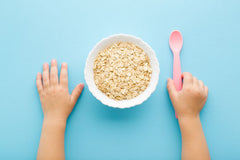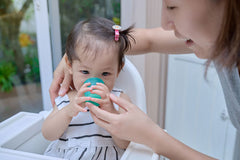
As much as parents everywhere don’t want to admit it, babies don’t keep. Eventually, that chubby little baby turns into an independent toddler, learning about the world and discovering new things every day. They crave independence, and as difficult as it might be, parents must allow and encourage it.
Part of your little one getting bigger is ditching the bottle and beginning the process of self-feeding. Cup training, spoon training, and learning not to throw every utensil on the floor are all hurdles to overcome. It might seem like a daunting task, but with the right products and support, the transition will be a breeze.
Self-Feeding Safety Tips

Before your baby begins self-feeding, it’s important to recognize potential risks and understand safety measures. A great way to make sure everyone in your household is prepared is to take a class on choking and infant resuscitation.
A few signs to look for that indicate your baby might be ready to start exploring more foods are:
- Interest in your food
- Proper head control
- Weight has doubled since birth
Eventually, your baby will start watching you eat with great interest and will open their mouth in anticipation of you sharing. Once they start this behavior, look for proper head control to minimize choking risks and ensure they are about double their birth weight. Once you see all these signs, it might be time to start self-feeding!
What Tools Do I Need to Introduce Self-Feeding?
There are tons of baby products out there to help transition your baby away from the bottle and begin their self-feeding journey.
3 of our favorite products to start the self-feeding journey are:
Mini Cup Training System
This system from EZPZ is a great starting point for parents looking to begin cup training. The cup is made entirely of food-grade silicone and is easy to clean, so it’s perfect for the sticky messes that might come with self-feeding.
This cup training system can be used with or without the straw and lid. Little ones may find it easier to transition to cups using a straw, or they may have a knack for cup training with an open top. Whatever your baby needs to begin cup training, this set is perfect.
Kit to Begin Self-Feeding
We love this self-feeding kit from Numnum for several reasons. First, it includes two different types of spoons and a handy no-spill bowl. Second, this is a great kit to introduce when your baby starts teething, as one of the spoons doubles as a teething toy. This helps baby become acquainted with utensils and explore different shapes and textures.
As a bonus, these types of teething spoons help immensely when you start brushing your baby’s teeth. The size and textures of the spoons help your baby get used to the feel of a toothbrush. Since these two things might happen around the same time, this product does double duty!
Mini Utensils for Spoon Training
Babies lack fine motor skills, but they are necessary for beginning their self-feeding journey. These mini utensils are perfect for spoon training; the materials are safe for baby, and they are large enough for little hands to grasp and practice those fine motor skills.
When Should I Start Cup Training?
Knowing when to begin self-feeding efforts is tricky. Your child will be going through several big changes at once during this time, so you may have to work around things like teething, learning to crawl, transitioning to a sleep sack, and more. It’s best not to overwhelm little ones with too much change at once.
The ideal time to start cup training is somewhere around six months old, give or take a few weeks. You might be surprised to see how instinctual cup training is for your child. Whether you’re using an open cup or one with a straw, they should get the hang of cup training pretty quickly.
How Do I Begin Cup Training?

Cup training shouldn’t be difficult or frustrating. If you find that it is, it’s okay to put the cup away and try another time. Start by letting your baby explore empty cups of all shapes, sizes, and materials.
Once they are comfortable with cups, add small amounts of water or milk to the cup and help them bring it to their mouth. The liquid should stimulate them to open their mouth and swallow, but it might take a little time! You may have to hold the cup for a while to avoid spills, but doing so independently will come to them in due time.
When Can I Begin Spoon Training?
Spoon training might be a little more difficult than cup training, and that’s okay! You don’t have to start solids to begin spoon training. You can feed small amounts of milk to your little one with a spoon, which will help them become acquainted with utensils.
You can begin spoon training your baby as early as four to six months, dependent on when your pediatrician clears you to start. Keep in mind that even though they may know how to eat from a spoon, they will not reach independence with spoon training until around 10 to 12 months.
How Do I Start Spoon Training?
As with any other transition, spoon training will be more successful if you allow your baby to play with and explore different spoons and utensils before trying to use them. Always make sure you use utensils made for babies; they are thicker and are less likely to become a choking hazard.
Once you’re ready to start your spoon training, just bring the spoon to your baby’s mouth, and their reflexes will kick in, ready to eat! Though it seems simple, remember that your baby may not enjoy spoon training at first because they won’t get their food as quickly.



Leave a comment